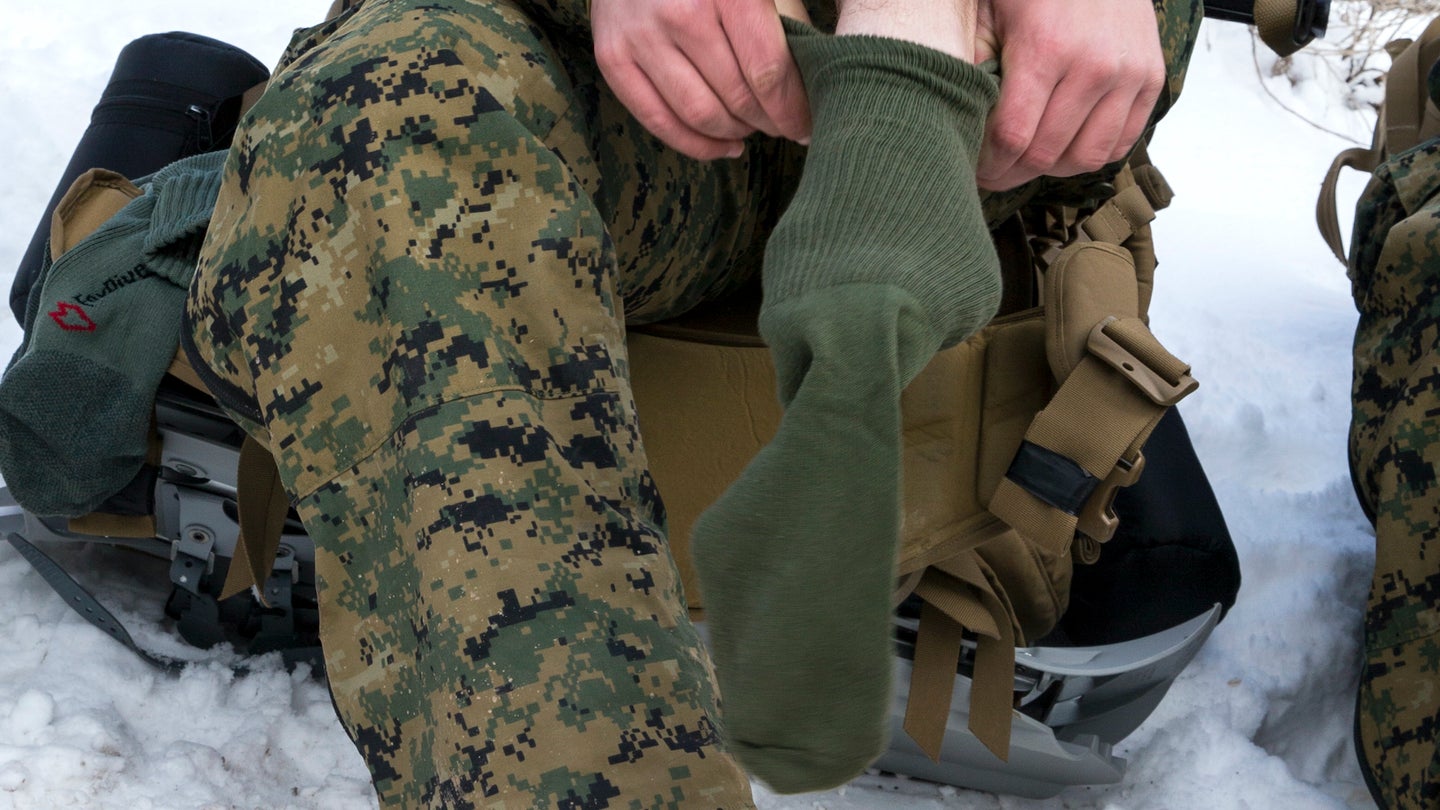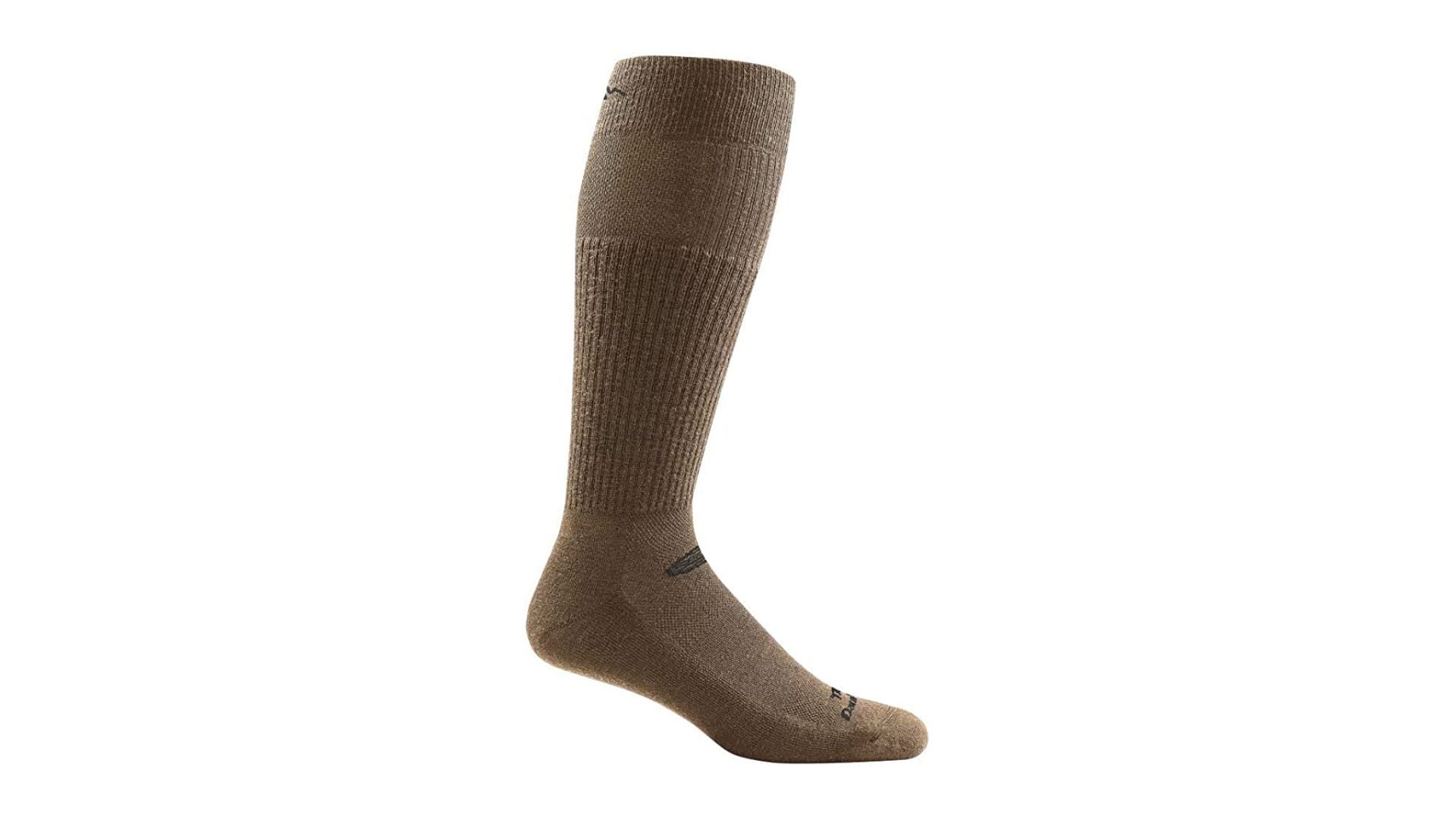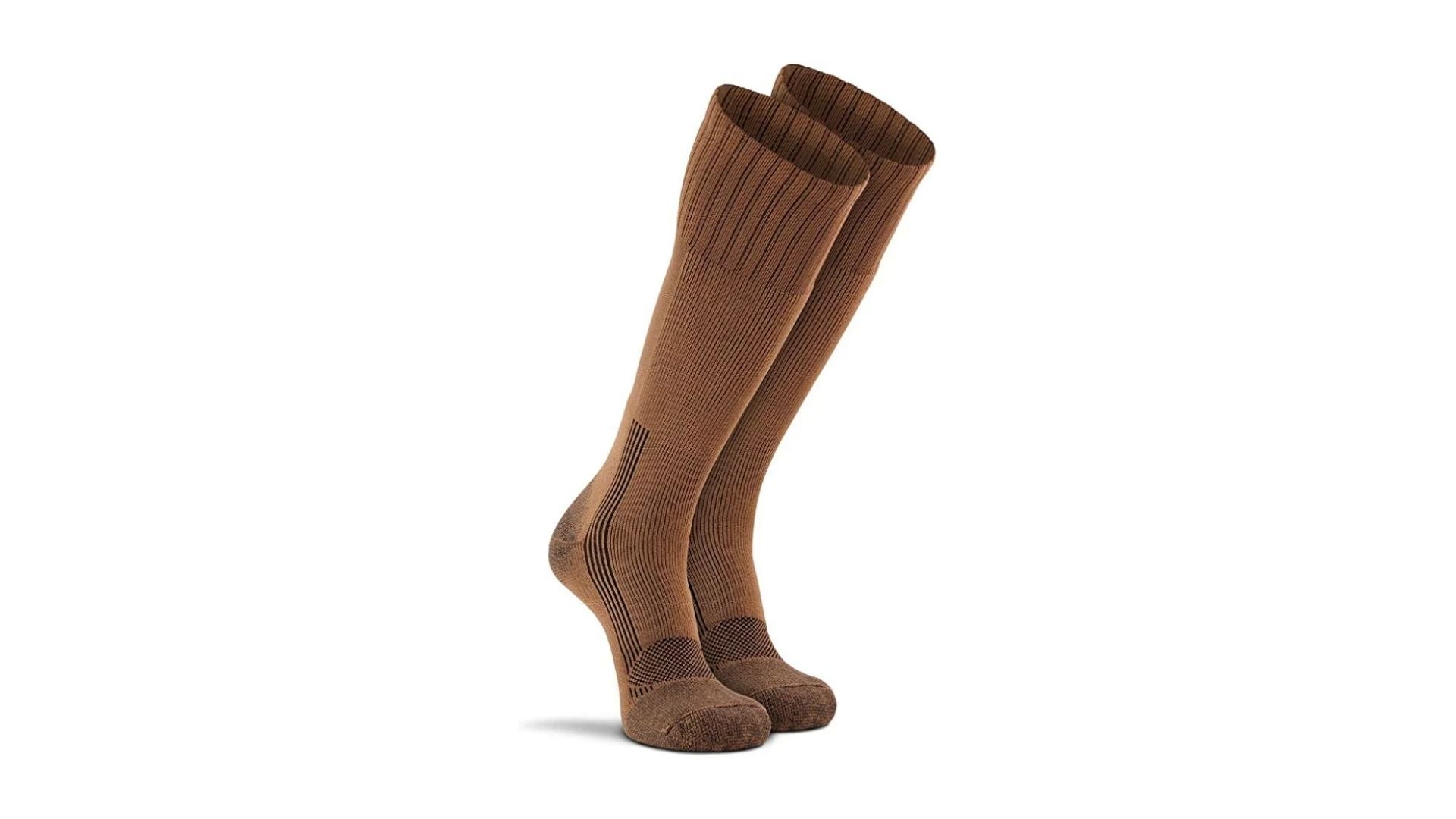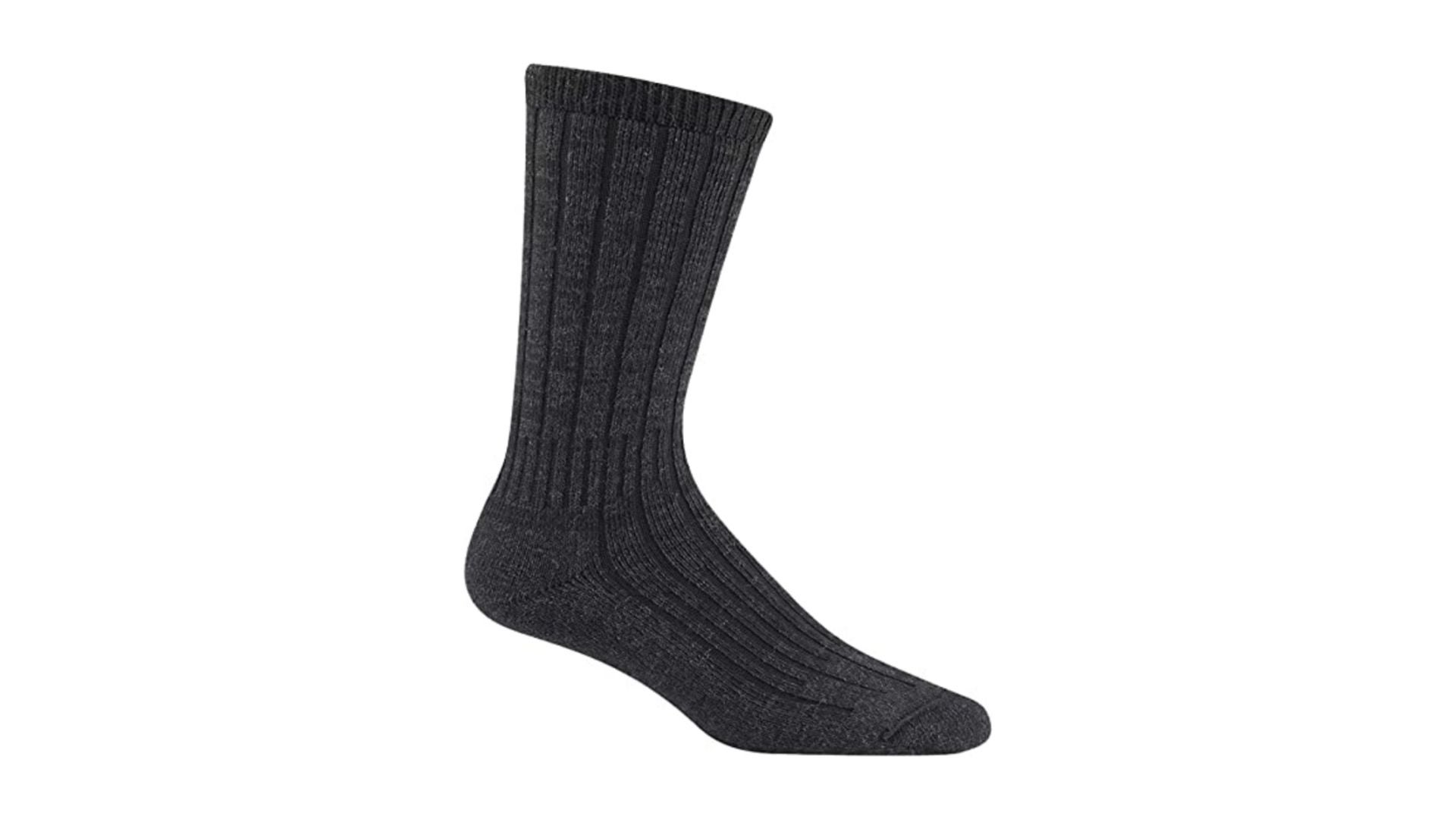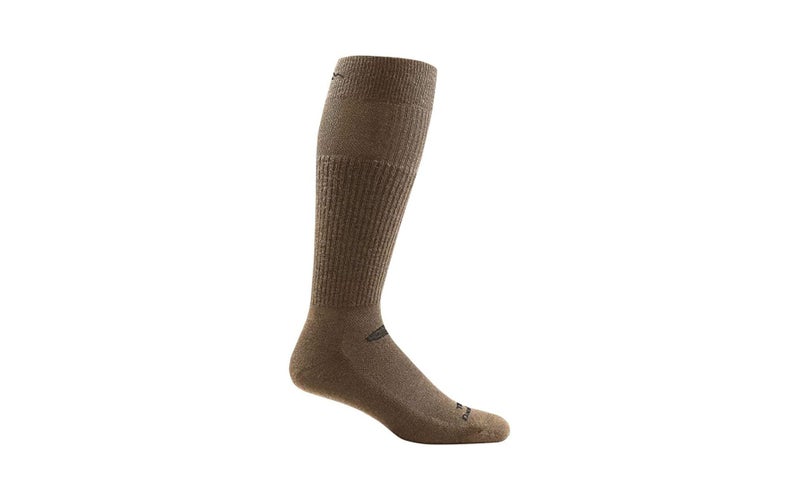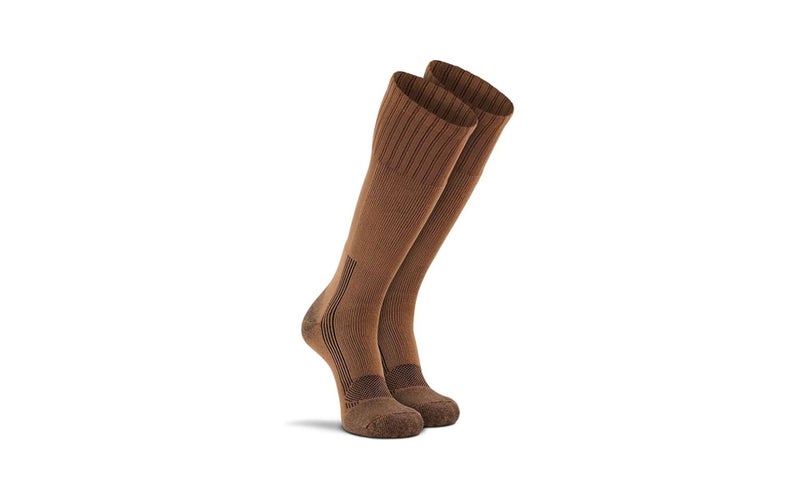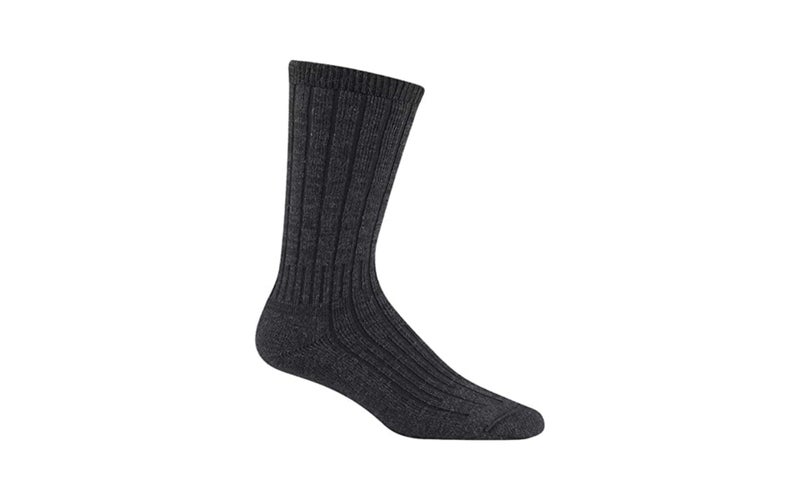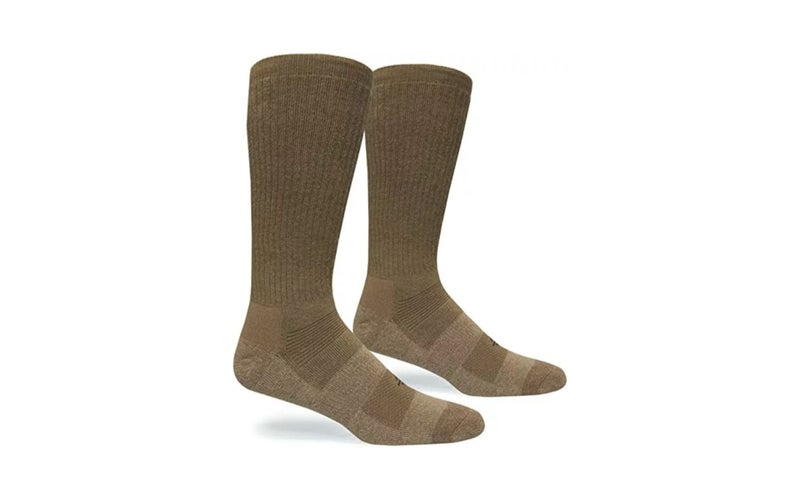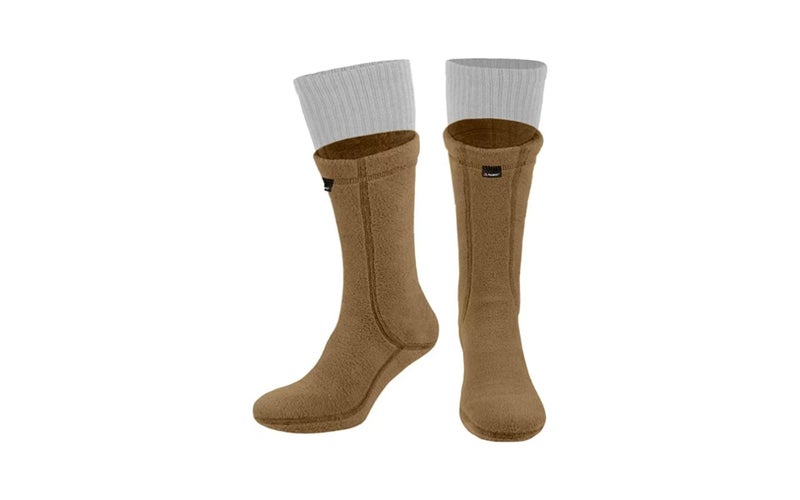We may earn revenue from the products available on this page and participate in affiliate programs.
Military socks are an often overlooked aspect of the wide world of tactical gear. Blisters, soreness, and peeling skin are huge threats that can take even the most physically capable person down, and these socks help prevent that. Don’t settle for the five-pack of Defense Logistics Agency socks that you were issued in boot camp. As simple as fabric tubes closed at one end sound, the best military socks will actually keep you fighting on your feet for longer, so make sure that your feet are well-protected, no matter the situation.
- Best Overall: Darn Tough Tactical Mid Calf Light Cushion Sock
- Best Value: Fox River Military Wick Dry Maximum Medium Mid-Calf Boot Socks
- Best for Hiking: Wigwam Merino Silk Hiker
- Best for Hot Weather: Covert Threads Desert Military Boot Socks
- Best Cold Weather: 281Z Polartec Fleece Winter Socks
Darn Tough is one of the most reputable brands in outdoor socks. When I first joined the Marine Corps, nearly everyone recommended Darn Tough over Bates socks. While the Vermont-based company leads in quality and popularity, it also promotes socks made in America with American materials.
The Darn Tough T3005 — or Mid-Calf Lightweight Tactical Sock with Cushion — blends a soft feel and a lightly cushioned sole with mild compression, all of which set it up to be your best friend in the field. These socks are made with Merino wool, which is known for being less itchy and more moisture-wicking than standard wool, in addition to being more breathable. The result is an incredibly comfortable sock that does an excellent job of keeping your feet dry and blister-free in the field. Darn Tough also has a great military discount program, further lowering the cost of the socks, and its warranty is essentially no-questions-asked, meaning that when you inevitably burn a hole in your socks, you can simply turn them in for new ones.
These are midweight socks, which means they’re designed to be a happy medium. For where I live in Virginia, that’s perfect, but when I went to Integrated Training Exercise in Twentynine Palms, California, the Mojave made me wish for a nuclear winter since these socks practically cooked my feet. If you’re in an extremely hot environment, look for dedicated hot-weather socks, and vice versa for extreme cold. Finally, these do have a tendency to roll down after prolonged use, which can be uncomfortable on your lower legs.
- Country of manufacture: USA
- Length: On the calf
- Materials: Wool, nylon, lycra
- These all-weather socks will protect you from moisture, impact, and swelling to keep you comfortable whether you’re in garrison or the field.
Comfortable
Great moisture wicking
Rock-solid warranty
Not as breathable as others
Top has a habit of rolling down
Not suitable for extreme temperatures
When preparing to attend Exercise Rolling Thunder in Fort Bragg in 2021, I was told to bring a new pair of socks for each day I was there because I wouldn’t be able to do laundry. Since 14 pairs of Darn Tough or Covert Threads would cost almost $300, I had to go with a cheaper option. That’s when I found Fox River socks. Despite costing much less than the top-tier brands, it’s a competent military sock deserving of a place in anyone’s utility wardrobe.
The Fox River Wick Dry Military Boot Socks have a lot going for them. They’re constructed from mid-weight materials, so they’re most comfortable in temperate climates. They’re also available at most PXs. But what really makes them stand out is the price. You can typically find them priced below $15 for a single pair.
The biggest issue with Fox River socks is that they’re not the most durable, and my socks have developed holes, which is the issue that many other users have had. Another issue is that they’re all-synthetic, which makes them less breathable and slightly more sweaty than others. All of these issues largely stem from lower quality control, and that combined with the non-Berry Amendment compliant imported materials and production explains the lower cost.
- Country of manufacture: USA and others
- Length: On the calf
- Materials: Polypropylene, nylon, spandex
- Fox River makes solid socks for a solid price, coming in at roughly half the price of most other options.
Half the price of other options
Readily available at many PXs
Good for a wide variety of environments
Wears out easily
Not as comfortable as other options
Not Berry-compliant
Silk blend socks are the standard for long-distance hikers due to their ability to all but eliminate the risk of blistering, while also remaining warm enough to use in cooler weather. Legendary brand Wigwam takes advantage of the smoothness and durability of silk to make these socks shine in ways that wool, cotton, and synthetic socks cannot. Gone are the days of people wearing silk stockings underneath their boot socks as the only way to fight blisters; these blend silk and breathable fabrics like Merino wool to make these a fantastic boot sock for the long haul.
The Wigwam Merino Silk Hiker socks lead the pack in long-term comfort and blister reduction, and that’s due to the addition of the one material that no other sock on this list has: silk. The smoothness of silk mitigates the friction between your foot and the boot, ensuring that blisters are almost no factor. The softness and full cushion of these socks, combined with the blister mitigation, mean that your feet won’t get pounded to death over hard terrain, either. Finally, in spite of the thickness, Wigwam has placed ventilation panels at key points in the sock’s construction to keep moisture wicking and breathability up.
These socks are still thick, however, so if you’re in extremely hot weather, they may become uncomfortable, and may not fit if your boots are snug. They’re also not cold-weather socks, despite their thickness, so don’t expect them to behave like thermal socks. Finally, they’re crew-length socks, which I don’t prefer, since they barely come over the tops of my boots, and sometimes slide down, leaving the leather around the tops of my boots to create hot spots on my calves.
- Country of manufacture: USA
- Length: Crew
- Materials: Wool, nylon, silk, spandex
- These socks take advantage of silk to improve insulation, reduce blisters, and, overall, improve comfort. In addition, they’re from legendary brand Wigwam, which has been a household name in hiking for decades.
Excellent moisture wicking
Fights blisters
Very soft
Too thick for hot weather
Short sock may not be to everyone’s liking
Not suitable for extreme temperatures
As a company, Covert Threads says its goal is making “comfortable yet rugged socks that stand up to the rigors of harsh climates and conditions.” And as far as I can tell, it’s true. The Desert Military Boot Socks are equipped with features that afford comfort in hot desert areas.
The Covert Threads desert socks use materials that prioritize breathability, such as cotton and Coolmax technology, to make sure that heat buildup in your feet is as little of a factor as possible. These socks also allow for the movement of air and small amounts of water, such as with sweat, owing to the ventilation panels all over the socks that are designed to drain sweat as it forms. Finally, they’re over-the-calf socks, meaning that they won’t slide down easily or bunch up, and are tall enough to prevent sand from getting in your footbed, which is a very real threat in the desert.
The use of cotton is great for breathability, but terrible for any kind of moisture shedding, meaning these aren’t socks that have crossover potential in the jungle or temperate environments, given that cotton will retain water if it’s introduced in large quantities and damage the skin of your feet. They’re also still relatively thick, in spite of their breathability, meaning they’re great for heavier-duty use, but not necessarily the most breathable for garrison wear. Finally, in my experience, Covert Threads socks have worn out faster than other socks from other brands of similar thicknesses.
- Country of manufacture: USA
- Length: Over the calf
- Materials: Cotton, acrylic, lycra, Coolmax, nylon, Ionic+
- The desert demands a sock that prioritizes breathability above all other characteristics, and this sock’s high-tech materials, open weave, and over-the-calf fit ensures your feet stay as cool as possible.
Supremely breathable
Does not retain sweat
Tall enough to keep sand out
Not suitable for moist environments
Wears out fast
Too thick for light duty use
When we say cold weather, we mean arctic, and so does Ukrainian brand 281Z. These are more over-socks than actual socks. They’re designed to add a layer of extreme warmth in environments that plunge below zero. Think of these as Polartec “brown bear” fleeces for your feet, designed for your next excursion to Bridgeport, Fort Drum, or Norway.
Polartec over-socks for extreme cold weather sound like just what the doctor ordered on extremely cold days. Thinking back to even the coldest day I’ve experienced, which was minus 14 degrees Fahrenheit, I was desperately trying to double up on socks, and these would have helped. These aren’t just practical for warmth reasons though, since doubling up on socks like this will also all but eliminate blisters, due to adding a layer against friction. The Polartec material is also great cushioning, meaning that these are very comfortable, especially for standing for long periods of time.
Adding all that thickness is inevitably going to negatively affect the fit of your boots, and if you anticipate working in extreme cold, you may want to go up a half size in your boots. Another issue is that doubling up on socks can reduce the stability of your footing, since your foot now has much more fabric between it and the insole, so these are best for people who stand still. Complicating this further, these are too much for people who are extremely active, even in extreme cold, since you will warm up and sweat. Finally, they’re not Berry Amendment compliant, owing to being made in Ukraine, and other 281Z products I’ve owned have had issues with the stitching staying in place.
- Country of manufacture: Ukraine
- Length: Crew
- Materials: Polartec
- Extreme cold calls for extreme socks, and these boot liners from 281Z are certainly extreme. Extremely warm.
Extremely warm
All but eliminate blisters
Added boot cushion
May require larger boots to properly fit
May reduce footing stability
Not Berry-compliant
Things to consider before buying military socks
Socks are crucial tools in keeping your feet uninjured and preventing any sort of temperature- or moisture-related injury. Because of this, they’re specially formulated to tackle the tasks, footwear, and hazards associated with military usage.
Materials
- Wool socks: Merino wool adds breathability, warmth, and comfort, but can make the socks itchy or overly hot in temperate climates.
- Cotton socks: Great for breathability, but extremely susceptible to moisture retention. Good for desert environments.
- Nylon and other synthetic fabrics: Formulated to address shortfalls with breathability, cushioning, or moisture wicking with natural fibers, but oftentimes introducing issues of their own.
Ventilation panels
Ventilation panels are mesh sections of the socks, specifically placed at points where heat and moisture build up on the human foot. These enhance breathability but can be vulnerable spots for holes to form.
Cushioning
Walking over rough terrain is a part of the military experience, and while shock-absorbing soles from Vibram are on many of the best military boots, having cushioned soles, heels, and toes definitely help.
Berry Amendment compliance
The Berry Amendment (USC, Title 10, Section 2533a) stated that defense procurement must prioritize American producers for many products, including textile goods. Berry-compliant products will almost always be made in the U.S., of American materials, so it’s a good gauge for people who want to buy American.
Height
Higher socks, particularly over-the-calf socks, are more resistant to sliding down your leg over a period of time, but they can be warmer than short socks due to just having more material. Additionally, some people don’t like having tall socks, not liking the feeling of them on their legs. Conversely, crew socks, which go just above the tops of an eight-inch boot, can have issues sliding down, but have less material and are better for those who find over-the-calf socks to be too much.
FAQs about military socks
Q: What are the best military socks?
A: The best military socks depend on your environment and usage. More cushioning is better for long-term heavy-duty usage, but thinner socks breathe better. Cotton is better for dry, hot environments, but not great if there’s a chance of water. This list will help you choose accordingly.
Q: Why do soldiers need specific socks?
A: Wet and dirty feet can literally kill you in a tactical environment. Wet socks cause peeled, rotting skin, and can facilitate the growth of fungus, germs, and other infections. Military boots are also taller than hiking boots, to keep out dirt, insects, and other debris, meaning that ankle socks are a no-go. Because of this, specialized socks are necessary.
Q: Do Marines wear black socks?
A: Always have, always will.
Final thoughts
Socks were one of the first things that senior Marines told me to upgrade. It’s one of the cheapest ways to enhance comfort in the field, and it’s saved me blisters, injuries, and soggy feet. The only change I’d make would be to award a contract for the standard-issue boot sock to one of these companies.
Methodology
All of these socks are socks I’ve worn while hiking, skiing, and in my duties as a Marine Reservist in the field and in garrison. They’ve been selected for how well they stand above other options that I’ve tested from other brands, and how much of an improvement they are over the standard DLA socks.
